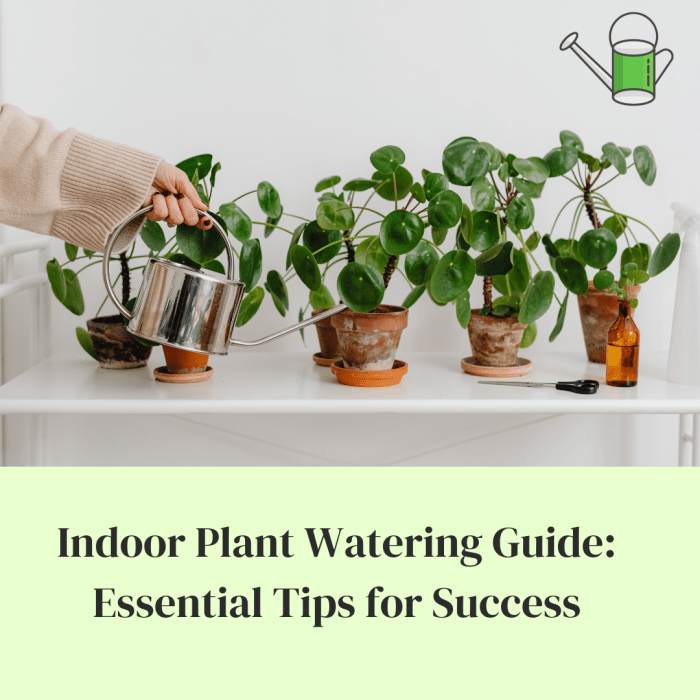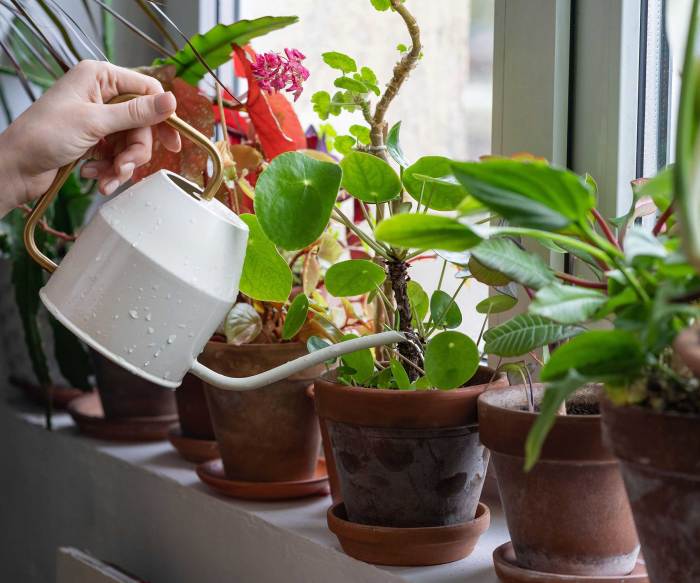How Much Do You Water Indoor Plants?
Factors Affecting Indoor Plant Watering Needs: How Much Do You Water Indoor Plants
How much do you water indoor plants – The frequency with which you water your indoor plants depends on a variety of factors. Understanding these factors is crucial for keeping your plants healthy and thriving.
Pot Size and Watering Frequency
Larger pots retain more moisture than smaller pots. A larger volume of soil takes longer to dry out, meaning plants in larger pots will require less frequent watering than those in smaller pots. A small pot might need watering daily, while a large one might only need it weekly.
Soil Type and Watering Requirements
Different soil types have varying water retention capabilities. Well-draining potting mixes, such as those containing perlite or vermiculite, dry out faster than dense, clay-like soils. Plants in well-draining mixes will need more frequent watering than those in heavier soils.
Plant Life Cycle and Watering
A plant’s water needs change throughout its life cycle. During periods of active growth (typically spring and summer), plants require more frequent watering to support new growth. Conversely, during dormancy (often autumn and winter), watering should be reduced significantly to prevent root rot.
Light Levels and Water Needs
Plants in bright, sunny locations generally dry out faster than those in low-light conditions. Increased light intensity increases transpiration (the process by which plants lose water through their leaves), thus requiring more frequent watering. Plants in shadier spots will need less frequent watering.
Watering Needs of Different Plant Types
Succulents, with their thick leaves and stems designed for water storage, require infrequent watering. Conversely, ferns, with their delicate fronds and high transpiration rates, need consistently moist soil. Other plants fall somewhere in between these two extremes.
Comparison of Watering Needs for Various Indoor Plants
| Plant Type | Water Frequency | Soil Type Preference | Light Requirement |
|---|---|---|---|
| Snake Plant | Low (every 2-3 weeks) | Well-draining | Bright indirect |
| ZZ Plant | Low (every 2-4 weeks) | Well-draining | Low to bright indirect |
| Peace Lily | Medium (every 1-2 weeks) | Well-draining | Medium to low |
| Boston Fern | High (every 1-2 days, depending on humidity and pot size) | Moist, well-draining | Bright indirect |
Watering Techniques
Several techniques can help you determine when and how to water your indoor plants effectively.
The Finger Test for Soil Moisture
1. Gently insert your index finger about an inch into the soil.
2. If the soil feels dry to the touch, it’s time to water.
3.
If the soil feels moist, wait a few more days before watering again.
4. For larger pots, check the moisture level at multiple points.
Using a Moisture Meter
Insert the moisture meter probe into the soil, following the manufacturer’s instructions. The meter will display a reading indicating the soil moisture level. Adjust watering frequency based on the reading.
Bottom Watering
Benefits: Ensures even watering, reduces the risk of overwatering, and is ideal for plants sensitive to wet leaves.
Drawbacks: Slower watering process, not suitable for all plant types.
Top Watering

Source: gardeningbaron.com
Benefits: Convenient and quick method.
Drawbacks: Can lead to uneven watering and surface crusting, increasing the risk of overwatering if not done carefully.
Visual Guide to Watering Different Pot Types
Imagine a series of illustrations. The first shows top watering a terracotta pot, emphasizing how the porous nature of the pot requires more frequent watering. The second depicts bottom watering a plastic pot, showing how water is absorbed from the bottom, preventing overwatering. The third illustrates watering a self-watering pot, highlighting the reservoir and how to monitor the water level.
Signs of Overwatering and Underwater
Recognizing the symptoms of both overwatering and underwatering is crucial for taking corrective action.
Visual Signs of Overwatering
Yellowing leaves, wilting (despite moist soil), soggy soil, and root rot are common indicators. Leaves may also develop brown or mushy spots.
Symptoms of Underwater
Dry, brittle soil, wilting leaves (that perk up after watering), leaf drop, and curling or browning leaf edges are telltale signs.
Addressing Overwatering Issues, How much do you water indoor plants
Remove the plant from its pot, inspect the roots, and remove any rotten or mushy roots. Repot the plant in fresh, dry soil. Reduce watering frequency and improve drainage.
Reviving an Underwatered Plant
Gently water the plant thoroughly, allowing excess water to drain. Increase watering frequency and monitor the plant closely for signs of recovery.
Common Problems from Improper Watering and Solutions
- Problem: Yellowing leaves. Solution: Check for overwatering or nutrient deficiencies.
- Problem: Wilting leaves. Solution: Check for overwatering or underwatering. Adjust watering frequency accordingly.
- Problem: Leaf drop. Solution: Check for underwatering, pests, or disease.
- Problem: Brown leaf tips. Solution: Check for underwatering or salt buildup in the soil.
Seasonal Watering Adjustments
Watering needs fluctuate throughout the year due to changes in temperature, humidity, and light levels.
Adjusting Watering Schedules by Season
Watering frequency should generally increase during the warmer months (spring and summer) when plants are actively growing and transpiration rates are higher. Reduce watering frequency during the cooler months (autumn and winter) when growth slows and the plant’s water needs decrease.
Impact of Humidity Changes

Source: futurecdn.net
Higher humidity levels reduce the rate of transpiration, meaning plants will need less frequent watering. Conversely, low humidity can increase transpiration, necessitating more frequent watering.
Modifying Watering Practices Based on Environmental Conditions
In heated environments, plants dry out faster, requiring more frequent watering. In air-conditioned environments, the opposite is true. Consider the impact of heating and cooling systems on your plants’ water needs.
Monthly Watering Adjustment Calendar

Source: futurecdn.net
| Month | Plant Type (Example: Snake Plant) | Watering Frequency | Notes |
|---|---|---|---|
| January | Snake Plant | Every 3-4 weeks | Reduce watering due to lower light and temperature |
| April | Snake Plant | Every 2-3 weeks | Slightly increase watering as light and temperature increase |
| July | Snake Plant | Every 2 weeks | Increase watering due to higher temperatures and light |
| October | Snake Plant | Every 3 weeks | Gradually decrease watering as days get shorter and cooler |
Water Quality and its Effects
The quality of the water you use significantly impacts your plants’ health.
Importance of Appropriate Water
Using water that is too hard (high in minerals) or too alkaline (high pH) can lead to nutrient deficiencies and hinder plant growth. Chlorine and fluoride in tap water can also harm plants.
Tap Water vs. Filtered Water
Filtered water is generally preferable to tap water for indoor plants, as it removes chlorine, fluoride, and other potentially harmful chemicals. Tap water can be treated to remove these elements (see below).
Treating Tap Water for Plants
Let tap water sit out overnight to allow chlorine to dissipate. Alternatively, boil the water for a few minutes to remove chlorine and other impurities. Consider using a water filter specifically designed for plants.
Using Rainwater
Rainwater is an excellent choice for watering indoor plants, as it’s naturally soft and free of chemicals. Collect rainwater in a clean container and allow it to sit for a day before using.
Top FAQs
Can I use ice cubes to water my indoor plants?
While it might seem convenient, using ice cubes is generally not recommended. The concentrated cold can shock the plant’s roots and potentially damage them. It’s best to water with room temperature water.
How often should I fertilize my indoor plants?
Fertilizing frequency depends on the plant type and growing season. Generally, fertilizing every 2-4 weeks during the growing season (spring and summer) is sufficient. Reduce or stop fertilizing during dormancy (fall and winter).
What should I do if my plant is drooping?
Drooping can indicate both underwatering and overwatering. Check the soil moisture; if dry, water thoroughly. If the soil is wet, you might have overwatering, requiring you to adjust your watering schedule and potentially repot the plant in fresh, well-draining soil.
My plant’s leaves are yellowing. What could be the cause?
Yellowing leaves can be due to several factors, including overwatering, underwatering, nutrient deficiencies, or disease. Investigate the soil moisture and consider adjusting your watering schedule or providing fertilizer if needed. If the problem persists, consult a plant care expert.





















